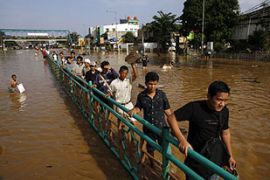Climate change threatens SE Asia
Study predicts climate change will hit major regional economies the hardest.

Researchers said large coastal populations in Indonesia and the Philippines could face rising sea levels between 40 and 70 centimetres, while rice production in Thailand and Vietnam could drop by half due to water shortages.
Some experts said the ecosystem was also at risk, warning that more than 2,800 plant species could become extinct as carbon levels in the air double.
‘Enormous cost’
In total, the annual cost of unmitigated climate change to these nations could total more than 6.5 per cent of their combined GDP, according to 250-page The Economics of Climate Change in Southeast Asia: A Regional Review, billed as the largest regional report of its kind.
|
“The clear message we want to deliver is that we have to take action now or… the cost will be enormous” Tae Yong Jung, ADB economist and report’s co-author |
Tae Yong Jung, a co-author and a senior economist at the ADB, told Al Jazeera the report was a “medium-high emission scenario” based on climate change figures from the UN and the UK.
“We are only forecasting the climate impact on the region’s economies specifically on the [four] major countries in this region,” he said.
“The clear message we want to deliver is that we have to take action now, otherwise by the end of the century or by the end of 2200 the cost will be enormous.”
Climate change is already affecting Southeast Asia, with higher temperatures, decreasing rainfall, rising sea levels, greater frequency and intensity of extreme weather events leading to widespread flooding, landslides and drought.
Climate change is also exacerbating the problem of water stress, affecting agricultural yields, triggering forest fires, damaging coastal marine resources, and increasing outbreaks of infectious diseases.
The report urges Southeast Asian countries to treat climate change adaptation as a key part of development policies, such as altering agricultural practices to take in changes in temperature and precipitation, and adapting water management to greater risk of floods and droughts.